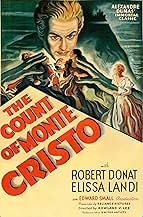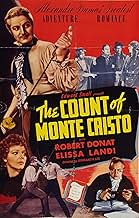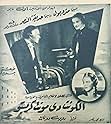IMDb RATING
7.4/10
3.6K
YOUR RATING
After greedy men have Edmond Dantes unjustly imprisoned for 20 years for innocently delivering a letter entrusted to him, he escapes to get his revenge on them.After greedy men have Edmond Dantes unjustly imprisoned for 20 years for innocently delivering a letter entrusted to him, he escapes to get his revenge on them.After greedy men have Edmond Dantes unjustly imprisoned for 20 years for innocently delivering a letter entrusted to him, he escapes to get his revenge on them.
- Awards
- 3 wins total
Featured reviews
There's a sentence but no trial to make your case, those you trust have had you interred at great haste, you've lost your love and future wife, must live in conflict and in strife, to wither in a cell while being laid to waste. But there's hope when you find out you're not alone, as a pair you set to work removing stone, excavating day and night, searching for the sight of light, until a tragedy, and your future is resewn. You inherit your dead partners wealth and riches, it allows you to acquire the finest britches, plus a title and some land, now revenge can be well planned, all because of nimble hands and threaded stitches.
A perpetually enduring tale, magnificently performed and presented, albeit with poetic license.
A perpetually enduring tale, magnificently performed and presented, albeit with poetic license.
No film version can substitute for reading the unabridged version of The Count of Monte Cristo. No doubt there is no substitute for reading it in French, but for English-speakers Robin Buss' 1996 English translation reportedly captures the both spirit and letter of Dumas' novel better than previous translations. In my opinion, the 1934 film also captures the spirit of the book, but omits many characters and story lines, and adds or rewrites others. Nevertheless, this film version is fun to watch.
Delightful film of the classic stage warhorse, a bit creaky and slow starting, but with cumulative power sustained by the subtle yet vivid characterizations. Each principal has a uniquely nuanced personality, brought forth by gesture and language -- something sorely lacking in today's 90 percent trash. NOTE FOR CINASTES: I never fully appreciated the comic outrages of Jame's Whale's use of the Hermit in Bride of Frankenstein until I saw the prototype, created here by the same actor, O. P. Heggie. The Hermit in "Bride" is a gleeful, unabashed parody of Faria, even in the crescendo of music that mimics the "Ave Maria" in the Whale picture. I'm sure Whale wondered if his in-joke would be caught, and by how many. See the picture and you'll understand.
THE COUNT OF MONTE CRISTO (United Artists/Reliance, 1934), directed by Rowland V. Lee, from the immortal novel by Alexandre Dumas, and personally supervised by Edward Small, capitalized on the current trend of literary works adapted to the motion picture screen. It stars British import Robert Donat, making his Hollywood debut, in fact, his only one as a leading performer on U.S. soil. He would spend the duration of his career in British-made productions, thus, later winning an Academy Award as best actor in another memorable performance in GOODBYE, MR. CHIPS (MGM, 1939) opposite Greer Garson.
For the benefit of those unfamiliar with either the book or the motion picture(s), here is a brief summary: The story, which begins in 1815, finds Edmund Dantes (Robert Donat) a young sailor on a French ship who has honored the dying request of his captain, LeClere (William Farnum), to carry a private letter to Napoleon on Elba. While ashore, he meets with Mercedes De Rosas (Elissa Landi), the woman he loves. Because Fernand (Sidney Blackner) loves Mercedes, he, along with others in his scheme, succeed to have Dantes arrested for carrying a secret letter and for this reason, unjustly imprisoned in the Château d'If. While in prison, Dantes is treated harshly and cruely by the guards, and Mercedes, although still in love with Dantes, finds herself marrying Fernand, later to bear him a son. Later, Dantes encounters Abbe Faria (O.P. Heggie), an old man imprisoned there for many years who spends his free time cutting his way through prison walls and digging a tunnel that would someday get him through to freedom. Over the years, Abbe Faria educates his friend Dantes by showing him a chart of the location of fabulous treasure on the island of Monte Cristo. While digging through the tunnel, there is a cave-in that crushes Abbe Faria's ribs, later the cause of his death. As the guards prepare to take the old man's body away, Dante switches places with the deceased, and hides himself in the burial sack. After being thrown into the ocean, Dantes breaks himself free.He is then rescued and picked up by Captain Camp (Mitchell Lewis), who makes him part of his crew. After shaving off his long beard, Dante locates the island of Monte Cristo and he goes ashore to possess the treasure, making him a very rich man. He then returns to France in the guise of The Count of Monte Cristo to then avenge his three enemies, Fernand, Raymond DeVillefort (Louis Calhern) and Danglars (Raymond Walburn), the men who had him unjustly sent to prison where he stayed for twenty years. How Dantes achieves his vengeance adds to the suspense and pleasure of the avid "revenge is sweet" viewer.
Also seen in the supporting cast are Georgia Caine as Madame De Rosas; Luis ALberni as Jacopo; Clarence Muse as the muted Ali; Douglas Walton as Albert De Mondego; Juliette Compton and Lionel Bellmore, among others. The memorable musical score by Alfred Newman would be repeated in latter films, notably the "Ave Maria" underscoring portion used for LES MISERABLES (20th Century, 1935) starring Fredric March.
Hailed by many as the very best and most memorable screen adaptation to the Dumas novel, this obviously goes without question. Aside from it being faithful to the book, the movie itself holds interest throughout, and Robert Donat's performance, ranks one of his best in his long but occasional screen career. Had this movie been produced a few years later, chances are that the Dantes character would have been played by the likes of future swashbuckling kings as Errol Flynn or Tyrone Power, or even Douglas Fairbanks Jr., for example, but although Donat's Edmund Dantes is one of the best ever to be recaptured on film, asthma and ill heath would prevent him from performing similar duties in future Hollywood swashbuckling adventures.
Unfortunately, film prints to THE COUNT OF MONTE CRISTO that have circulated on television and video since the early 1980s was the abridged 97 minute version, eliminating about 20 minutes worth of footage. If one were to locate a rare video copy either at a local library or a video store, chances are they would acquire a 1990s VHS format from Video Treasures, also being a shorter and "colorized" copy. While it's hard indicate what's been actually edited, the cuts are obvious, particularly through sudden blackouts during the plot followed by fade-ins to the middle of scenes that play like reading a middle of a chapter of a book without a new beginning. Also missing from those VHS copies is the cast of actors and their roles, something that existed on TV prints prior to 1980. Restoration to the film's original length (114 minutes) and crisp black and white photography finally turned up on Turner Classic Movies on July 6, 2008.
The success of THE COUNT OF MONTE CRISTO spawned sequels "in name only" in later years, including THE SON OF MONTE CRISTO (United Artists, 1940); THE RETURN OF MONTE CRISTO (Columbia, 1946), both featuring Louis Hayward as a descendant of Edmund Dantes; among others, as well as countless remakes and imitations, but this 1934 version still should hold interest today. Rarely seen in recent years, it did have a "colorized" television presentation on the Disney Channel in the early 1990s as part of its "Best of Hollywood" program, but like the Video Treasures copy, was not the complete version.
Regardless of print availability, the 1934 first sound version to THE COUNT OF MONTE CRISTO remains an adventure classic from the "golden age of Hollywood" that has stood the test of time. (***1/2)
For the benefit of those unfamiliar with either the book or the motion picture(s), here is a brief summary: The story, which begins in 1815, finds Edmund Dantes (Robert Donat) a young sailor on a French ship who has honored the dying request of his captain, LeClere (William Farnum), to carry a private letter to Napoleon on Elba. While ashore, he meets with Mercedes De Rosas (Elissa Landi), the woman he loves. Because Fernand (Sidney Blackner) loves Mercedes, he, along with others in his scheme, succeed to have Dantes arrested for carrying a secret letter and for this reason, unjustly imprisoned in the Château d'If. While in prison, Dantes is treated harshly and cruely by the guards, and Mercedes, although still in love with Dantes, finds herself marrying Fernand, later to bear him a son. Later, Dantes encounters Abbe Faria (O.P. Heggie), an old man imprisoned there for many years who spends his free time cutting his way through prison walls and digging a tunnel that would someday get him through to freedom. Over the years, Abbe Faria educates his friend Dantes by showing him a chart of the location of fabulous treasure on the island of Monte Cristo. While digging through the tunnel, there is a cave-in that crushes Abbe Faria's ribs, later the cause of his death. As the guards prepare to take the old man's body away, Dante switches places with the deceased, and hides himself in the burial sack. After being thrown into the ocean, Dantes breaks himself free.He is then rescued and picked up by Captain Camp (Mitchell Lewis), who makes him part of his crew. After shaving off his long beard, Dante locates the island of Monte Cristo and he goes ashore to possess the treasure, making him a very rich man. He then returns to France in the guise of The Count of Monte Cristo to then avenge his three enemies, Fernand, Raymond DeVillefort (Louis Calhern) and Danglars (Raymond Walburn), the men who had him unjustly sent to prison where he stayed for twenty years. How Dantes achieves his vengeance adds to the suspense and pleasure of the avid "revenge is sweet" viewer.
Also seen in the supporting cast are Georgia Caine as Madame De Rosas; Luis ALberni as Jacopo; Clarence Muse as the muted Ali; Douglas Walton as Albert De Mondego; Juliette Compton and Lionel Bellmore, among others. The memorable musical score by Alfred Newman would be repeated in latter films, notably the "Ave Maria" underscoring portion used for LES MISERABLES (20th Century, 1935) starring Fredric March.
Hailed by many as the very best and most memorable screen adaptation to the Dumas novel, this obviously goes without question. Aside from it being faithful to the book, the movie itself holds interest throughout, and Robert Donat's performance, ranks one of his best in his long but occasional screen career. Had this movie been produced a few years later, chances are that the Dantes character would have been played by the likes of future swashbuckling kings as Errol Flynn or Tyrone Power, or even Douglas Fairbanks Jr., for example, but although Donat's Edmund Dantes is one of the best ever to be recaptured on film, asthma and ill heath would prevent him from performing similar duties in future Hollywood swashbuckling adventures.
Unfortunately, film prints to THE COUNT OF MONTE CRISTO that have circulated on television and video since the early 1980s was the abridged 97 minute version, eliminating about 20 minutes worth of footage. If one were to locate a rare video copy either at a local library or a video store, chances are they would acquire a 1990s VHS format from Video Treasures, also being a shorter and "colorized" copy. While it's hard indicate what's been actually edited, the cuts are obvious, particularly through sudden blackouts during the plot followed by fade-ins to the middle of scenes that play like reading a middle of a chapter of a book without a new beginning. Also missing from those VHS copies is the cast of actors and their roles, something that existed on TV prints prior to 1980. Restoration to the film's original length (114 minutes) and crisp black and white photography finally turned up on Turner Classic Movies on July 6, 2008.
The success of THE COUNT OF MONTE CRISTO spawned sequels "in name only" in later years, including THE SON OF MONTE CRISTO (United Artists, 1940); THE RETURN OF MONTE CRISTO (Columbia, 1946), both featuring Louis Hayward as a descendant of Edmund Dantes; among others, as well as countless remakes and imitations, but this 1934 version still should hold interest today. Rarely seen in recent years, it did have a "colorized" television presentation on the Disney Channel in the early 1990s as part of its "Best of Hollywood" program, but like the Video Treasures copy, was not the complete version.
Regardless of print availability, the 1934 first sound version to THE COUNT OF MONTE CRISTO remains an adventure classic from the "golden age of Hollywood" that has stood the test of time. (***1/2)
This briskly paced, attractively packaged version of the Dumas classic continues to stand the test of time, owing in large part to Robert Donat, an actor for the ages, and a supporting cast which includes the able Louis Calhern as Donat's strongest enemy, the florid Raymond Walburn as the weakest, and the aristocratic beauty Elissa Landi as the love interest. The story itself is melodrama at its best, with the hook of an innocent man not only wronged by self-seeking villains but wronged in a spectacularly cold-blooded, inhuman manner: railroaded to a veritable dungeon for a crime he did not commit and left to rot forever, only to be saved by a chance encounter with a noble fellow prisoner who bequeaths to him the location of a hidden treasure which he uncovers after a daring escape from his confinement. And then, using his vast fortune, he plots a great act of justice for his enemies, now prominent personages of great corruption, not by stooping to their level, but by cleverly manipulating them into self-exposure and ultimate destruction.
Did you know
- TriviaThis is the version that "V" in V pour Vendetta (2005) claimed to be his favorite film.
- GoofsDuring the fencing duel between Dantes and Mondego, in one brief shot near the end Sidney Blackmer holds his sword in his left hand instead of his right, which he does in the rest of the scene. This was obviously a shown in reverse as is often done to add footage.
- Quotes
[last lines]
Albert de Mondego: [to Dantes and Mercedes who are up in the branches of a tree] Can we come up?
Edmond Dantes: Find your own tree.
- Crazy creditsPrologue: "1815--Napoleon had achieved an empire and lost it again. Exhausted by years of revolution and war, France strove to make peace with her neighbors under the rule of King Louis XVIII....while the "Little Corporal," now in exile, reigned over only a few square miles of land--Elba. But the memory of his colorful career still endeared him to the hearts of the people, and his loyal followers were actively conspiring to return him to power."
- Alternate versionsAlso available in a computer-colorized version.
- ConnectionsFeatured in MGM/UA Home Video Laserdisc Sampler (1990)
- How long is The Count of Monte Cristo?Powered by Alexa
Details
- Release date
- Country of origin
- Official site
- Languages
- Also known as
- The Count of Monte Cristo
- Filming locations
- Production company
- See more company credits at IMDbPro
Box office
- Gross US & Canada
- $3,270,000
- Runtime1 hour 53 minutes
- Color
- Aspect ratio
- 1.37 : 1
Contribute to this page
Suggest an edit or add missing content

Top Gap
By what name was Le comte de Monte Cristo (1934) officially released in India in English?
Answer




































